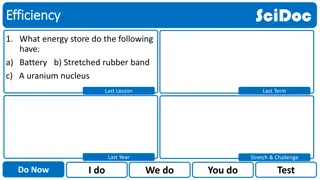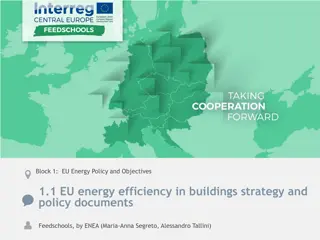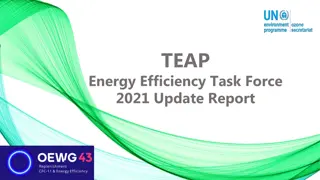Energy Efficiency Modeling Needs and Considerations
This content discusses the importance of building simulation in energy efficiency estimates, considerations for building modeling, and the challenges in obtaining calibration data and understanding performance variability. Expertise, data requirements, and tool choice are highlighted for accurate energy modeling.
Download Presentation

Please find below an Image/Link to download the presentation.
The content on the website is provided AS IS for your information and personal use only. It may not be sold, licensed, or shared on other websites without obtaining consent from the author.If you encounter any issues during the download, it is possible that the publisher has removed the file from their server.
You are allowed to download the files provided on this website for personal or commercial use, subject to the condition that they are used lawfully. All files are the property of their respective owners.
The content on the website is provided AS IS for your information and personal use only. It may not be sold, licensed, or shared on other websites without obtaining consent from the author.
E N D
Presentation Transcript
Modeling Needs and Considerations for Energy Efficiency Ex Ante and Ex Post Savings Estimates Jeff Hirsch Consultant - CPUC Ex Ante Team September 18, 2015 Workshop: Energy Modeling Tools and their Applications in Energy Efficiency September 18, 2015 1
Is Building Simulation Needed? Yes, sometimes It can assist in obtaining estimates When whole building/environment interactions are important Weather variations, HVAC and other component interactions When detailed component variations are of interest Insufficient lab or field data is available to directly estimate performance variation 2
Is Building Simulation Needed? No, sometimes It can get in the way When interactions can be added with sufficient accuracy When sufficient monitoring data (lab and/or field) is available to characterize performance in a separate model (simplified or complex) When component level what if variations are not needed or the data isn t available to support the estimates 2
Considerations for Building Modeling Prototypes of typical buildings or site specific models Significant data requirements for envelope, lighting and plug loads, HVAC, process, controls and operation, weather Calibration data whole building, enduse for sufficient period(s) to capture full variation of annual use Time and money, expertise 3
Considerations for Building Modeling Modeling tool choice Similar accuracy and reliability of components being examined and the interacting components that significantly impact comparative energy use Details of components being studied are modeled accurately, the inputs allow complete description of technology variations and outputs allow verification of calibration Debugging and updating of tool is possible and timely; expertise is available Effort level and cost for full project is manageable 5
Biggest Challenges Looking Forward Availability of sufficient calibration data Understanding of variability of performance May require both laboratory and field work Can take a lot of time and money Development of new component models Identifying measures of interest and requirements for model capabilities Facilitating production use by wider community 6























